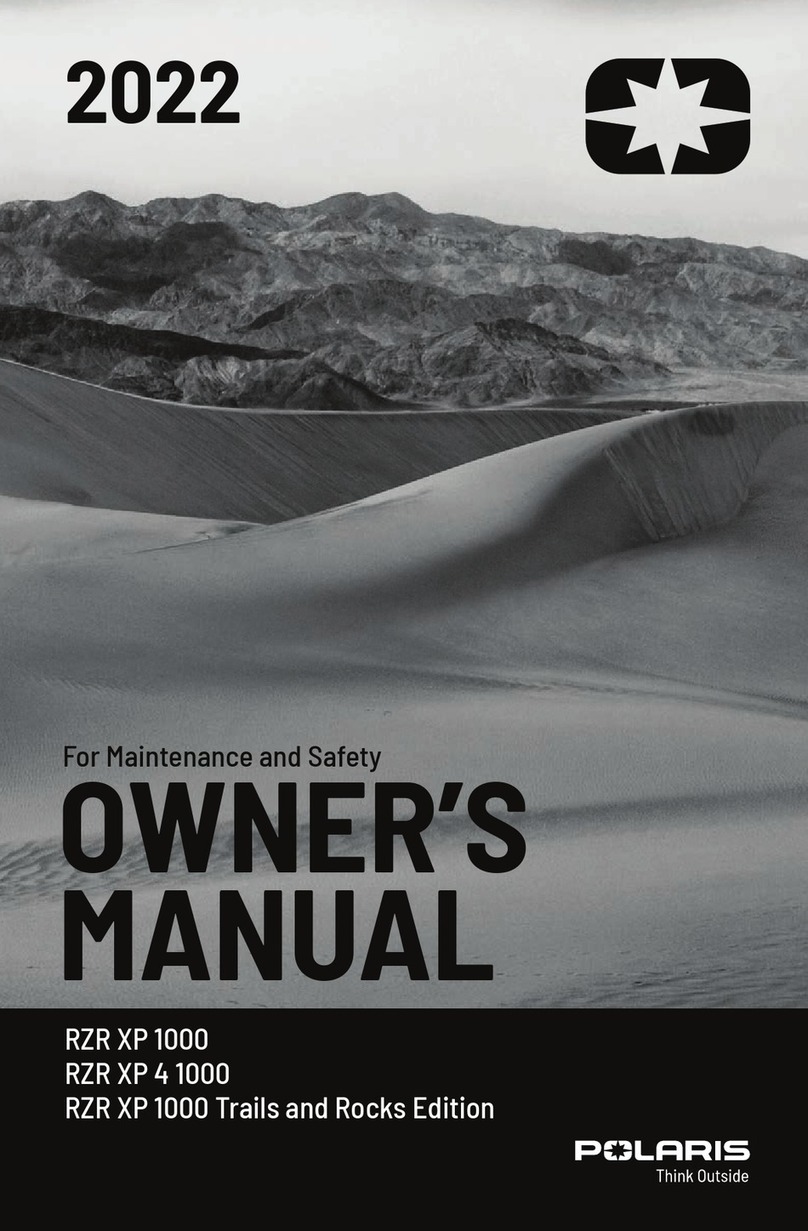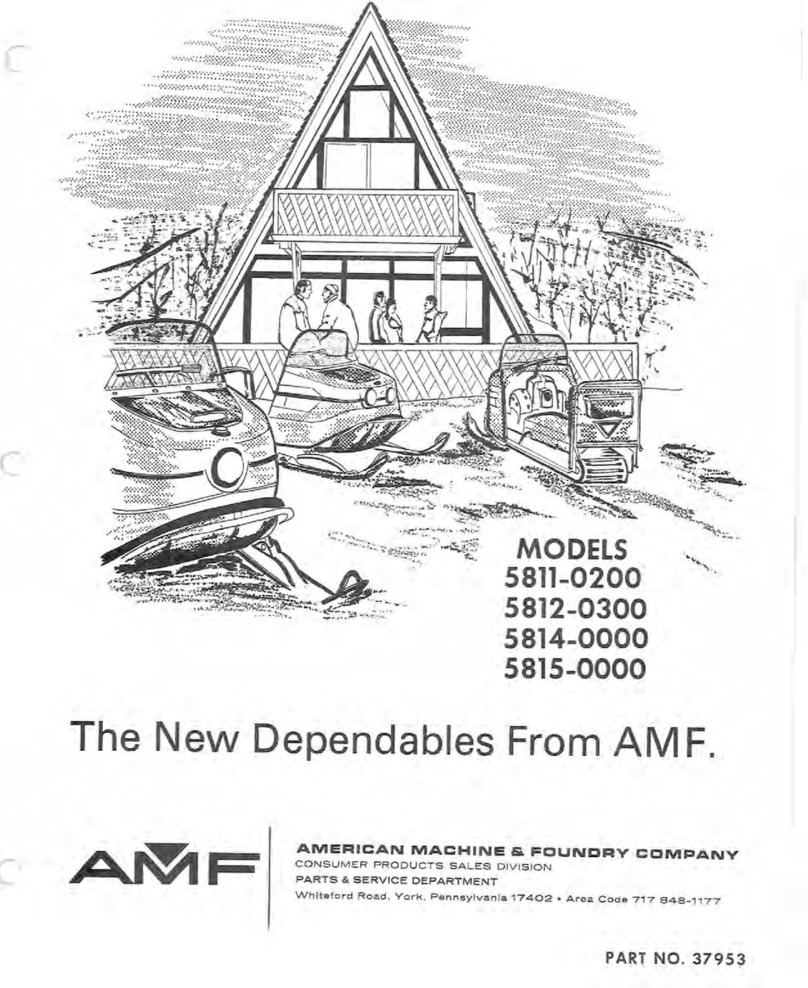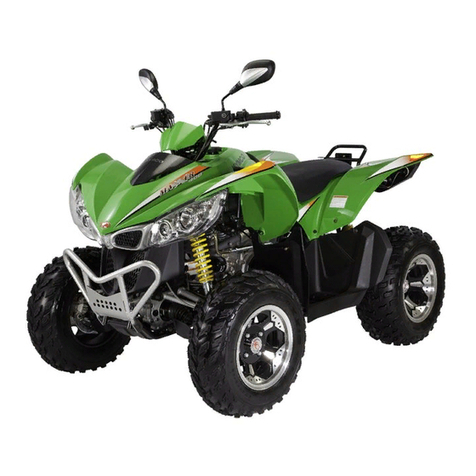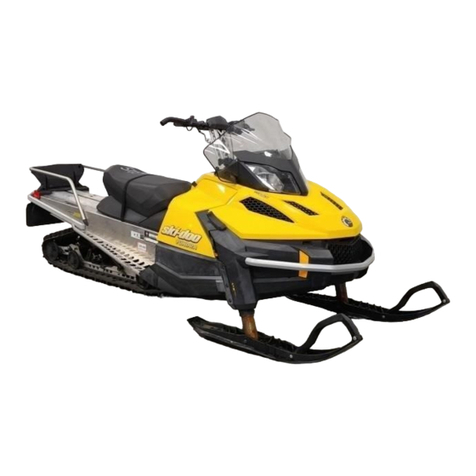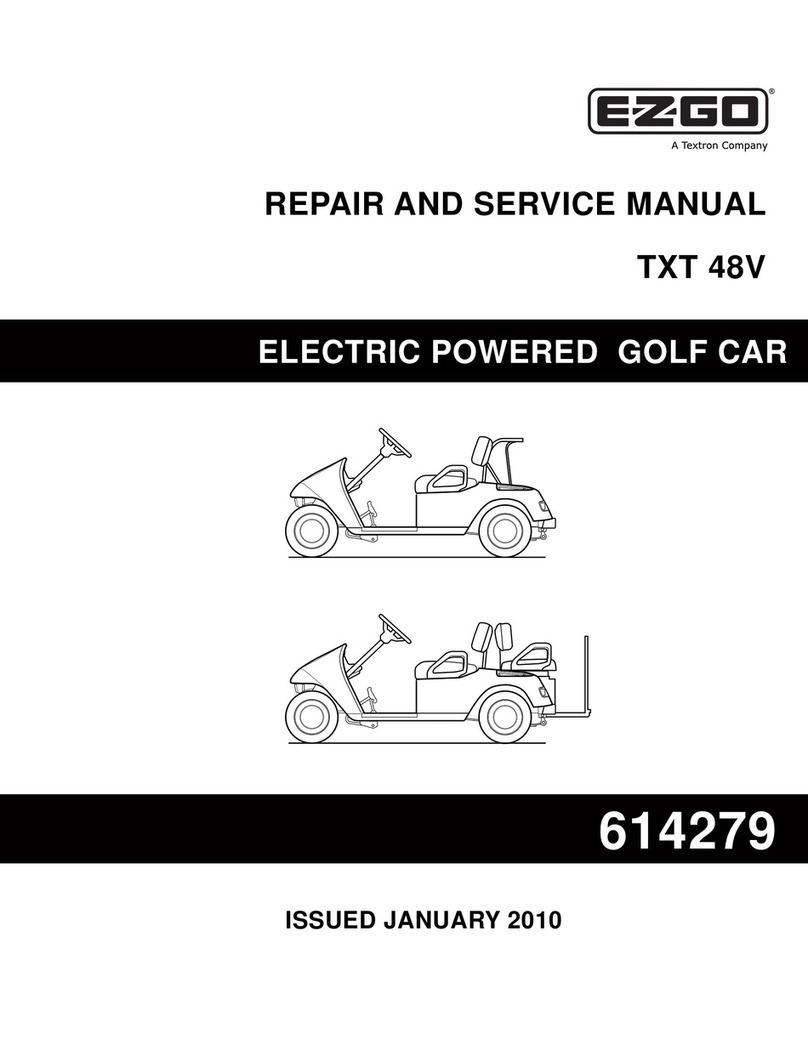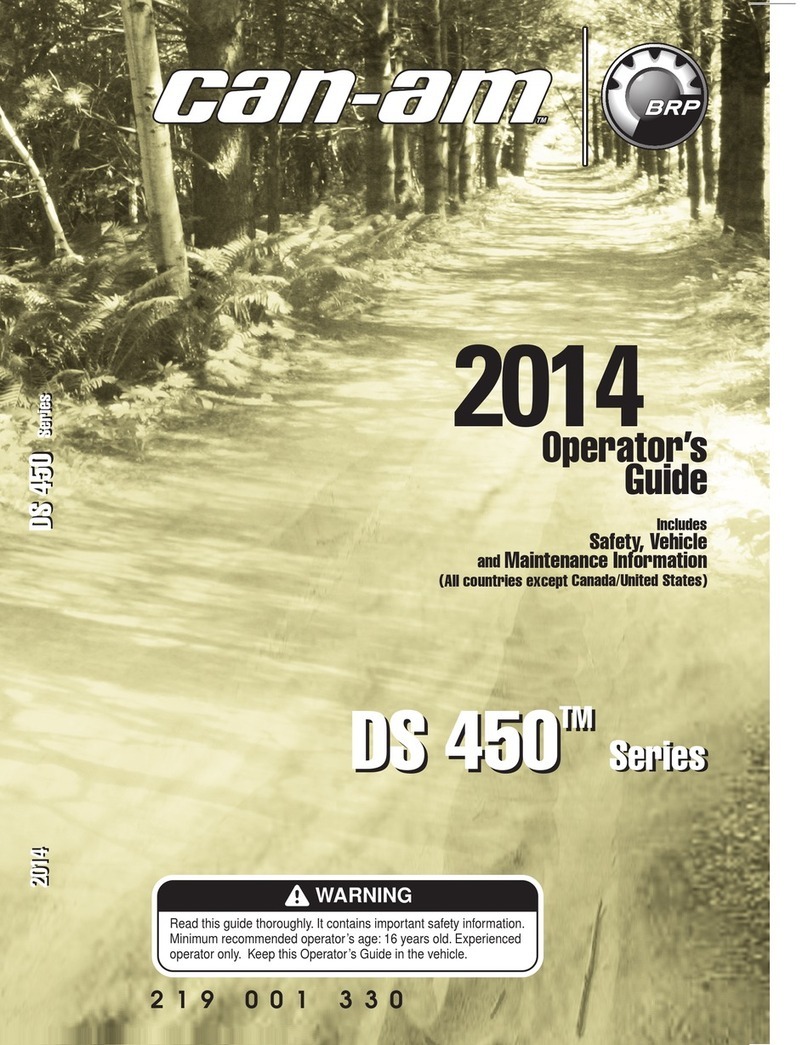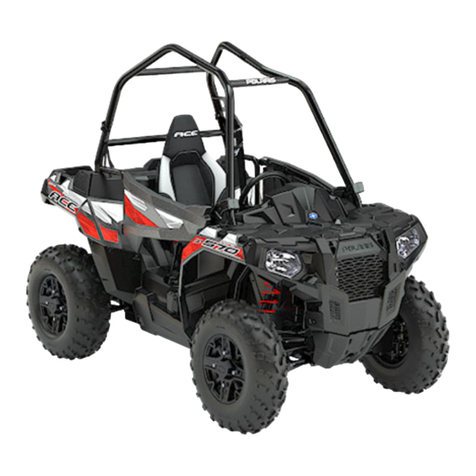LIYA E-ZR50 User manual

- 1 -
ELECTRIC MINI ATV
E-ZR50
OWNER’S MANUAL
Read and understand this entire manual before using!
NOTE: Manual illustrations are for demonstration purposes only.
Illustrations may not reflect exact appearance of actual product.
Specifications subject to change without notice.
OFF ROAD USE ONLY!!!
NEVER OPERATE THIS VEHICLE IF YOU ARE UNDER
AGE 12!!!

- 2 -
INTRODUCTION
Thank you for purchasing this mini ATV. The proper care and maintenance that your vehicle
requires is outlined in this manual. Following these instruction will ensure a long trouble-free
operating life of this vehicle and your satisfaction with it.
The owner’s manual corresponded to the latest state of this vehicle at the time of printing.
Slight deviations resulting from continuing development and design can, however, not be
completely excluded. All specifications are non-binding, we reserve the right to modify or
delete technical specification, parts, design, etc…without prior notice.
SAFETY WARNINGS
This vehicle is NOT A TOY and ONLY used in closed off areas remote from public road traffic.
Never permit children under age 12 to operate this ATV.
Adult’s supervision is required if children under age 16.
WARNING: Riding an electric mini ATV can be a hazardous activity. Certain conditions may
cause the equipment to fail without fault of the manufacturer. Like other electric vehicles, the
Mini Quad can and is intended to move, and it is therefore possible to lose control, fall off
and/or get into dangerous situations that no amount of care, instruction or expertise can
eliminate. If such things occur you can be seriously injured or die, even when using safety
equipment and other precautions. RIDE AT YOUR OWN RISK AND USE COMMON SENSE.
This manual contains many warnings and cautions concerning the consequences of failing to
maintain, inspect or properly use your mini ATV. Because any incident can result in serious
injury or even death, we do not repeat the warning of possible serious injury or death each
time such a possibility is mentioned.
APPROPRIATE RIDER USE AND PARENTAL SUPERVISION
This manual contains important safety information and use tips to help you and your child
operate and handle the mini ATV. Carefully read the manual in its entirely together with your
child before letting your child ride it for first time. The manual also contains important
information on servicing the vehicle.
It is your responsibility to review the manual and make sure that all riders understand all
warnings, cautions, instructions and safety topics and assure that the riders are able to safely
and responsibly use this product and protect your child from injury. We recommend that you
periodically review and reinforce the information in this manual with your child, and that you
inspect and maintain your children’s vehicle to insure their safety. The recommended rider
age of 12 years is only an estimate, and can be affected by the rider’s size, weight or skills.
Any rider unable to fit comfortably on the mini ATV should not attempt to ride it.
It is important and necessary to conduct the technical training for your child before first
use. To get the train information, please contact the dealer who you purchase the
vehicle from. Before your child complete the training, do not let your child use this
vehicle.
Children often underestimate or fail to recognize the dangerous situation, you should make it
clear to your child that should not, under any circumstances, operate the vehicle without
supervision and that your child may only drive at speed that are commensurate with the child’s
riding ability and other road condition.
A parent’s decision to allow his or her child to ride this vehicle should be based on the
child’s maturity, skill and ability to follow rules.

- 3 -
Keep this product away from small children younger than age 12 and remember that this
product is intended for use only by persons who are, at a minimum, completely comfortable
and competent while operating the vehicle.
DO NOT EXCEED THE WEIGHT LIMIT OF 145LBS ( 65KGS). Rider weight does not necessarily
mean a person’s size is appropriate to fit or maintain control of the mini ATV
Do not touch the brakes or motor on your vehicle when in use as they can become very
hot.
Refer to the following section on safety for additional warnings.
ACCEPTABLE RIDING PRACTICES AND CONDITIONS
Always check and obey any local laws or regulations which may affect the locations
where the vehicle may be used.
Ride defensively. Watch out for potential obstacles that could catch your wheel or force you to
swerve suddenly or lose control. Be careful to avoid pedestrians, skaters, skateboards,
scooters, bikes, children or animals who may enter your path, and respect the rights and
property of others.
The mini ATV is meant to be used on private property and on closed courses and not on public
streets or sidewalks. Do not ride your mini ATV in any areas where pedestrian or vehicle traffic
is present.
Do not activate the speed control on the hand grip unless you are on the MINI ATV and in a
safe, outdoor environment suitable for riding.
This product was manufactured for performance and durability but are not impervious to
damage. Jumping or other aggressive riding can over-stress and damage any product,
including the Mini ATV, and the rider assumes all risks associated with high-stress activity.
Be careful and know your limitations. Risk of injury increases as the degree of riding difficulty
increases. The rider assumes all risk associated with aggressive riding activities.
Never carry passengers or allow more than one person at a time to ride the electric mini quad.
Never use near steps or swimming pools.
Never use alcohol or drugs before or while operating
Keep your fingers and other body parts away from the drive chain, steering system, wheels
and all other moving components.
Never use headphones or a cell phone when riding.
Never hitch a ride with another vehicle.
Do not ride the vehicle in wet or icy weather and never immerse the electric mini quad in water,
as the electrical and drive components could be damaged by water or create other possibly
unsafe conditions.
Wet, slick, bumpy, uneven or rough surfaces may increase risks of use. Do not drive the
electric four wheeler in mud, ice, puddles or water. Avoid excessive speeds that can be
associated with downhill rides. Never risk damaging surfaces such as carpet or flooring by use
of an electric four wheeler indoors.
Do not ride at night or when visibility is limited.
PROPER RIDING ATTIRE
Always wear proper protective equipment such as an approved safety helmet, elbow pads and
kneepads. A helmet may be legally required by local law or regulation in your area.

- 4 -
A long-sleeved shirt, long pants and gloves are recommended. Always wear athletic shoes,
never drive barefooted or in sandals, and keep shoelaces tied and out of the way of the wheels,
motor and drive system.
USING THE CHARGER
The charger supplier with the vehicle should be regularly examined for damage to the cord,
plug, enclosure and other parts, and in the event of such a damage, the bike must mot be
charged until the charger has been repaired or replaced.
Use only with the recommended charger.
Use caution when charging.
The charger is not a toy. Charger should be operated by an adult.
Do not operate charger near flammable materials.
Unplug charger and disconnect from bike when not in use.
Always disconnect from the charger prior to wiping down and cleaning the vehicle with liquid.
FAILURE TO USE COMMON SENSE AND HEED THE ABOVE WARNINGS INCREASES
RISK OF SERIOUS INJURY. USE WITH APPROPRIATE CAUTION AND SERIOUS
ATTENTION TO SAFE OPERATION.
WARNING STICKER LOCATION

- 5 -
Sticker A as below is located on the left front fender.
Sticker B as below is located on the right front fender
Sticker C as below is located on the right front fender
Sticker D as below is located on the left front fender.

- 6 -
Sticker E as below is located on the rear swing arm
Sticker F as below is located on the chain cover
LOCATION OF PIN
PIN is stamp marked on an aluminum plate that is riveted on the rear swing arm
PIN means the Product Identify Number which is unique for each unit.
BEFORE YOU BEGIN
Remove contents from box. Remove the foam separators that protect the components from
damage during shipping. Inspect the contents of the box for scratches in the paint, dents or
kinked cables that may occurr during shipping. Because the product was 85 percent
assembled and packed at the factory, there should not be any problems, even if the box has a
few scars or dents.
Estimated Assembly and Set-Up Time
We recommend assembly by an adult with experience in motorbike or bicycle mechanics.
Allow up to 30-60 minutes for assembly
Required Tools

- 7 -
Some tools may be supplied; however, we recommend the use of mechanic’s grade tools. Use
the supplied tools only as a last resort.
The list of tool required is as follows:
·Open end wrench 10mm / 13mm-15mm / 14mm-17mm / 24mm
·Allen wrench 5mm / 6mm / 10mm·Bicycle style tire pump with pressure gauge
Assembly illustration and instruction
ASSEMLY REAR WHEEL
A: Nut M16 1pc
B: WasherΦ16.5*30*3 1pc
C: Rear wheel
D: split pin 2pcs
E: Rear axle
1. Fix the wheel(C) through the axle.
2. Mount the spring washer (B) and then tighten
the nut (A) securely with 24mm open end
wrench.
3. Install the 2pcs split pin.
ASSEMBLY FRONT SHOCK ABSORBER
A: Bolt M10*40 2pcs
B: front shock
C: Nut M10 2pcs
1. Uplift the frame to align the shock (B) mounting
hole to the shackle joint hole.
2. Fix the bolt (A) through the shock mounting hole
and shack joint and tighten the nut (C) securely
with 13mm -15mm and 14mm -17mm open end
wrench
ASSEMLY FRONT WHEEL
A: Wheel suspension left and right
B: Bolt M10*85*1.5 2pcs
C: Nut M10 2pcs
1. Put the front wheel suspension (A) into the front
swing arm joint, align the bearing hole to the joint
upper and bottom hole.
2. Mount the bolt (B) through the hole and twist the
nut (C),tighten it securely with 14mm - 17mm open
end wrench and 10mm allen wrench.

- 8 -
ASSEBMLY TIE ROD
A :Bolt M8*30 2pcs
B: Spring waher Φ8 2pcs
C: Tie rod left and right 2pcs
D: Waher Φ8 2pcs
E: Nut N8 2pcs
1. Align the hole of tie Spring waher (B), tie rod end
ball (C), Waher (D) in sequence.
2. Mount the bolt(A) and tighten the nut (E)
securely with 13mm - 15mm open end wrench and
6mm allen wrench.
ASSEMLY BUMPER
A: Nut M8 2pcs
B: Bumper
C: Bolt M8×16 4pcs
1. Align the bottom mounting hole of bumper (B) to
the frame bottom joint and mount the bolt (C), NOT
tighten the bolt to keep the bumper free move.
2. Turn upwards the bumper to align the upper
mounting hole of bumper to the frame upper joint,
then mount the bolt (C) and twist the nut (A).
3. Tighten the bolt (C) and nut(A) securely with 10mm
and 13mm open end wrench
ASSEMBLY FRONT BRAKE CALIPER
A: Spring washer Φ6 4pcs
B: Bolt M6*12 4pcs
C: front brake caliper
1. Place the brake disc into the front brake caliper
(C) with the hole in alignment.
2. Mount the spring washer (A) and then tighten the
bolt (B) securely with 5mm allen wrench.

- 9 -
ASSEMBLY HANDLEBAR
WARNING:
Failing to properly adjust and tighten the bolts that affix the handlebars can cause you to lose
control and crash.
A: Bolt M8×50 4pcs B: Upper Clamp
C: Bottom Clamp D: handlebar cover
E: Handle bar
1. Put the bottom clamp(C) on the steering rod
plate with the screw hole in alignment, and
place the handlebar (E) in the bottom clamp,
then cover the upper clamp (B) on the
handlebar and install the 4pcs bolt (A).
2. Place the handlebar in the upright and vertical
position, then tighten all the bolts securely with
10mm open end wrench.
3. Put the cover on the handle bar.
HANDLE DRIVE CONTROLS
1: Front brake lever 2 :Forward & Reverse Switch--RED
3: Horn button switch 4: Lamp on/off switch---GREEN
5: Electricity volume meter 6: Accelerator grip 7: Rear brake lever
Remark:
1:Accelerator works while the KEY SWITCH in at ON position.
2:Press the reverse switch to move back, and reset the switch(press again) to go
forward.

- 10 -
Inflating the Tires
NOTE:The 6”rear tires are inflated when shipped, but they invariably lose some pressure
between the point of manufacturing and your purchase. Always inflate the tires to the correct
PSI before first time use.
Please read the specification sheet to get the information of tire pressure.
Using a bicycle-style tire pump to inflate the tire to the PSI indicated on the sidewall of the tire.
Note: The pressurized air supplies found at gasoline stations are designed to inflate
high-volume automobile tires. If you decide to use such an air supply to inflate your tires, first
make sure the pressure gauge is working, then use very
short bursts to inflate to the correct PSI. If you inadvertently over-inflate the tire, release the
excess pressure immediately.
Important information of use guider for tire
Note: Tire is the only contact between the vehicle to the road, the safety of various driving
activity depends on the small area of tire where contact with the road. Therefore, it is very
important to keep the tire in good condition any time and use the correct size and standard tire
to replace the old ones.
Guide:
Tire assembly and disassembly
It is strongly recommended that the tire assembly and disassembly should be done by an
authorized technician with necessary skills.
Tire inflating pressure
It is very important to keep the tire in proper pressure and check the tire pressure before use.
The inflating should be done while the tire is cold.
Tire maintenance
Tire tread depth should be checked regularly.( Shallower tread means less grip of tire). You
must stop to use the vehicle if the tire is pierced, disassemble the tire and check it carefully.
Tire maintenance should be done by an authorized technician. Tire should be replaced
immediately when it is distorted or damaged.
Tire replacement
It is important to use the correct size and standard tire as per our specification (see details in
technical specification sheet)
Don’t use the used tire if you are not sure its previous service condition.
Tire aging
Tire aging is unavoidable even the tire is not ever used or just used a few times. Tire aging is
mainly reflected in the cracked section on side of tire and tire tread, sometimes the tire is
distorted as well. The used and aged tire should be checked and confirmed if it is ok to use
again by an authorized technician

- 11 -
2-FUNCTION ADJUSTABLE SWITCH
The 2-function adjustable switch is located under the seat ( see above picture).
There are 2 letters standing for the different functions as follows,
R: Throttle response is adjustable from 0.2S to 1S in clockwise rotation
S: Top speed is adjustable from 8KM /H to 28KM/H in clockwise rotation
OPTIONAL PART ---REMOTE CONTROL
The remote control unit ( No.1 in above picture) is located under the seat, and the switch
Stop the motor: press the button ( No.3 in above picture)
Start the motor: quickly press the button 2 times ( No.2 in above picture)
Caution: The remote control works effectively within 30 meters only.

- 12 -
TECHNICAL SPECIFICATION SHEET
Motor type 1
1000W 36V
Motor type 2
1500W 48V
MAX. Power output 1000W36V
1.08KW/2500RPM
MAX. Power output 1500W48V
1.62KW/2950RPM
Max torque (1000W motor)
3.22Nm /2500RPM
Max torque (1500W motor)
5.48Nm/2780RPM
Battery
3 x 12V 12A lead acid battery
48V10A / 48V 13A lithium battery
Charger INPUT for 36V lead acid battery
100-240V/50-60 Hz/1.5A
Charger OUTPUT for 36V lead acid battery
44.0V-1.5A
Charger INPUT for 48V lithium battery
100-240V/47-63 Hz/2.0A
Charger OUTPUT for 48V lithium battery
54.6V-2.0A
Non-load input current
≤115mA
Maximum motor current controller output
32A±1.0A/1000W36V
30A±1.0A/1200W48V , 35A±1.0A/1500W48V
Transmission
Chain drive
Front suspension
double mechanical damper
Rear suspension
mono shock absorber
Tyre
Tubelss tyre,front 14*4.10-6, rear 14.00 x 5-6 with
10.00 P.s.i. operation pressure and 24 P.s.i Max.
inflate .
Brake system
front and rear disc brake
Rated loading capacity
65KG
Max. speed (1000W36V)
28KM/hour
Max. speed (1500W48V)
35KM/hour
Range per charge(36V12A)
19KM
Range per charge(48V10A)
18KM
Range per charge(48V13A)
24KM
Wheelbase(mm)
780
Dry Weight --(lead acid / lithium battery)
42KG / 49KG
Dimension (mm)
1165×725×765
Min ground clearance (mm)
70
Seat height (mm)
550
Carton size (mm)
1030*640*530

- 13 -
PRODUCT MAIN PART DIAGRAM

- 14 -
1. Handlebar cover
2. Front brake lever
3. Electricity volume meter
4. Throttle
5. Rear brake lever
6. Rear wheel & tire
7. Front swing arm
8. Bumper
9. Front brake caliper
10. Front wheel & tire
11. Front lamp ( L& R)
12. Key ignition
13. Reverse button switch
14. Main plastic body
15. Tail light
16. Chain cover
17. Rear brake caliper
18. Front suspension
19. Battery pack
20. Seat
21. Rear rack
22. Rear suspension
23. Motor
24. Footrest ( L & R)

- 15 -
BEFORE RIDING
Charging the Battery
Your electric mini ATV may not have a fully charged battery; therefore it is a good idea to
charge the battery prior to use.
· Initial charge time: 12 hours
· Run time: up to 45minutes
· Average battery life: 120 charge/discharge cycles
· Recharge time: Always remember to turn the power switch off and recharge for at least 10
hours after each use. When vehicle is not in regular use, recharge battery at least once a
month until normal use is resumed. If you have left the power switch on or your product has not
been charged for a long period of time the battery may reach a stage at which it will no longer
hold a charge.
WARNING:
Always disconnect your electric mini ATV from the charger before cleaning with liquid.
The charger has a small window with two LEDs to indicate the charge status. Red LED means
the battery is in charging and Green LED means the battery is full charged. Chargers have
built-in over-charge protection to prevent battery from being over-charged.
Be sure to properly align the groove on the charger input port with the corresponding
socket on the Mini Quad and tighten threads; otherwise, no charging action will occur.
Warning: Failure to recharge the battery at least once a month may result in a battery that
will no longer hold a charge.

- 16 -
How to charge the battery and change the fuse.
The fuse is pre-fitted by the factory into your battery pack. Before you use the vehicle for the
first time you will need to connect the power lead to the battery pack. Once you have
connected, connect your charger to the charge point on the removable battery pack and
Charge the quad for 10 hours before the first use. Ensure the keys are removed from the
vehilce whenever you charge, if you leave the key turned on while charging ,it will never
charge the quad fully. For the first initial charge, leave you vehicle on charge even if the
charger turns to green which will help to boost your batteries and increase overall battery life
and range per charge. After the initial 10 hours,disconnect your charger once the led on the
charger has turned to green. Never leave on charge unsupervised!
1) Connect the power lead to the battery pack.
2) Connect the charger to the charge point.
3) Ensure the ignition key is removed and charge for 10 hours.
Replacing the fuse guidance
1) Remove your battery pack from the vehicle.
2) Using a cross head screwdriver undo the 6 bolts that secure the top of the battery
casing.

- 17 -
3) Once you have removed the 6 screw,please carefully remove the top of the battery
casing (Please be aware there are electrical cables connecting the top section of
the case to the batteries in the lower section)
4) Locate the fuse holder within the battery pack. This is normally glued to the underside
of the battery pack lid.

- 18 -
5) Open the fuse holder and remove the fuse and replace with your spare fuse. Reverse
the procedure to refit the battery pack.
PRE-RIDE CHECKLIST
❑Loose Parts
Check and secure all fasteners before every ride. Make sure steering stem clamp bolts are
locked properly in place. There should not be any unusual rattles or sounds from loose parts or
broken components. If you are not sure, ask an experienced mechanic to check.
❑Brake
Check the brake for proper function. When you squeeze the lever, the brake should provide
positive braking action. When you apply the brake with the speed control on, the brake cut-off
switch will stop the motor.
❑Frame, Fork and Handlebars
Check for cracks or broken connections. Although broken frames are rare, it is possible for an
aggressive driver to bash into a curb or wall and wreck and bend or break a frame. Get in the
habit of inspecting yours regularly.
❑Tire Inflation
Periodically inspect the tires for excess wear, and regularly check the tire pressure and
re-inflate as necessary. If you get a flat tire, the inner tube can be patched or a new tube can
be purchased from Razor or an authorized repair center.
❑Safety Gear
Always wear proper protective equipment such as an approved safety helmet, elbow pads and
kneepads. Always wear shoes (lace-up shoes with rubber soles), never drive barefooted or in
sandals, and keep shoelaces tied and out
of the way of the wheels, motor and drive system
REPAIR AND MAINTENANCE
Turn power switch off before conducting any maintenance procedures.
❑Adjusting the Brake
The mini quad is with 2 front brake and 1 rear brake.
WARNING: The brake is capable of causing the electric mini quad to skid the tire throwing an
unsuspecting rider. Practice in an open area free from obstacles until you are familiar with the
brake function. Avoid skidding to a stop as this can cause you to lose control or damage the
rear tire.

- 19 -
REPAIR AND MAINTENANCE
❑Adjusting the chain
1. loosen the 4pcs nut (B)
2. loosen the screw (A) and press the
plastic buckle to remove the chain
cover.
3. loosen the chain adjuster nut (C),
adjust the chain properly ( refer to the
standard: chain can move freely up
and down about 4mm), then fasten the
nut (C) and (B)

- 20 -
❑Chain and Sprocket
The chain will typically have a “loose spot” and “tight spot” corresponding with a particular
sprocket rotational position. This is normal and common to all chain-driven vehicles due to
run-out tolerances of the freewheel and sprocket. Proper chain alignment must be maintained.
If the chain is noisy or rough running, check the lubrication, tension and alignment of the
sprockets, in that order. The tensioner arms must be aligned and free from binding and the
tensioner spring(s) must be operating correctly.
Warning:
To avoid a pinch or injury, keep fingers away from moving sprockets and chain
❑Battery Care and Disposal
Do not store the battery in temperatures above 75° F or below -10° F.
CONTAINS SEALED LEAD BATTERY. BATTERY MUST BE RECYCLED.
Disposal: Your product uses sealed lead-acid batteries which must be recycled or disposed of
in an environmentally sound manner. Do not dispose of a lead-acid battery in a fire. The
battery may explode or leak. Do not dispose of a lead-acid battery in your regular household
trash. The incineration, land filling
or mixing of sealed lead-acid batteries with household trash is prohibited by law in most areas.
Return exhausted batteries to a federal or state approved lead-acid battery recycler or a local
seller of automotive batteries.
Warning:
If a battery leak develop, avoid contact with the leaking acid and place the damaged battery in
a plastic bag. Refer to the disposal instructions above, if acid comes into contact with skin or
eyes, flush with cool water for at least 15 minutes and contact a physician.
Warning:
Battery posts, terminals and related accessories contain lead and lead compounds.
Wash hands after handling.
❑Charger
The transformer/charger supplied with the product should be regularly examined for damage
to the cord, plug, enclosure and other parts, and, in the event of such damage, the Mini Quad
must not be charged until it has been repaired or replaced.
Use ONLY with the recommended charger.
WARNING: To avoid a pinch or injury, keep fingers away from moving sprockets and chain.
WARNING: If a battery leak develops, avoid contact with the leaking acid and place the
damaged battery in a plastic bag. Refer to the disposal instructions as above. If acid comes
into contact with skin or eyes, flush with cool water for at least 15 minutes and contact a
physician。
Table of contents
Popular Offroad Vehicle manuals by other brands

GM International
GM International 2003 Cadillac DeVille owner's manual

Arctic Cat
Arctic Cat 2012 350 HS Operator's manual
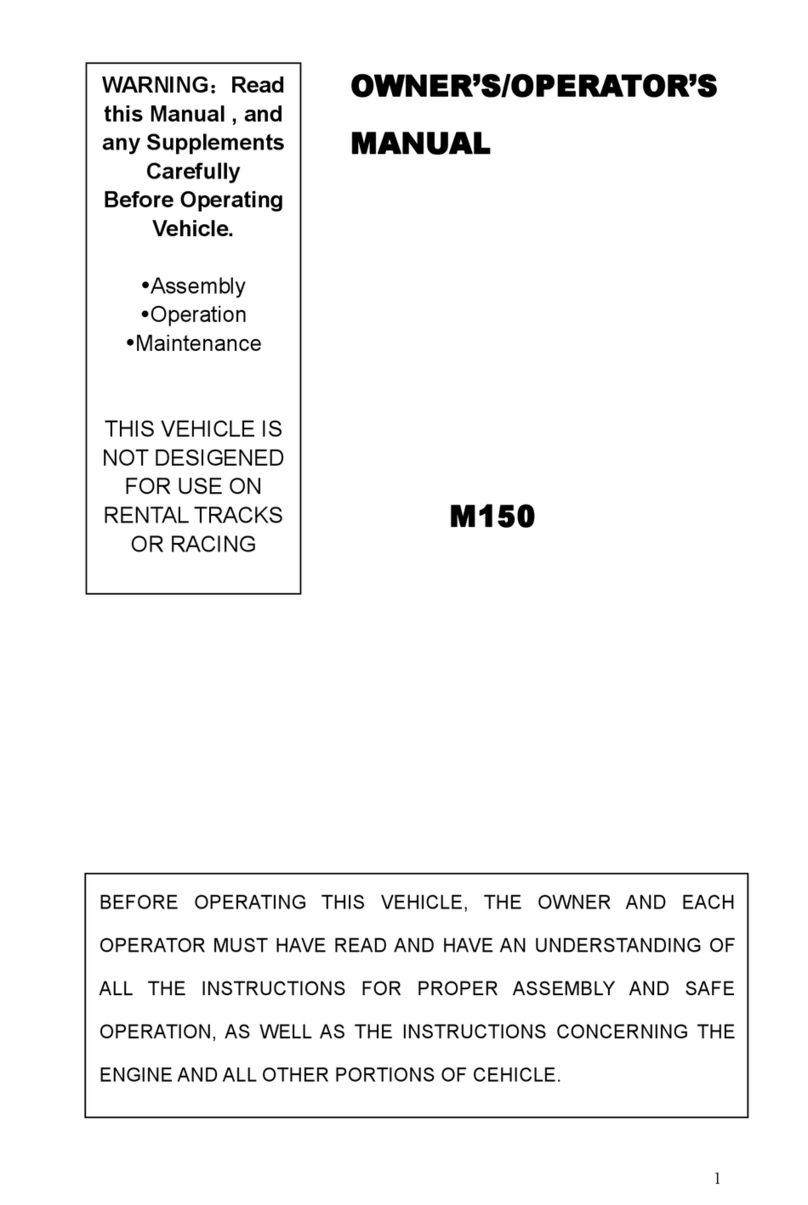
Tractor Supply
Tractor Supply M150 Owner's/operator's manual
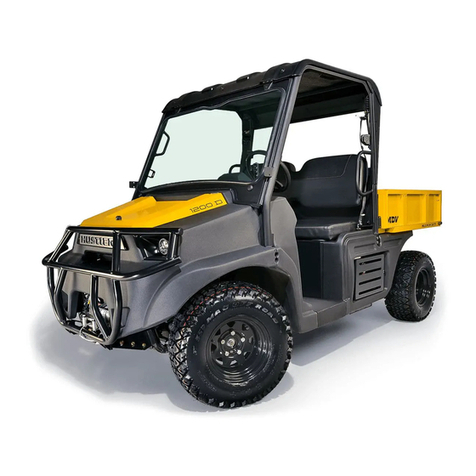
HUSTLER
HUSTLER MDV Operator's manual
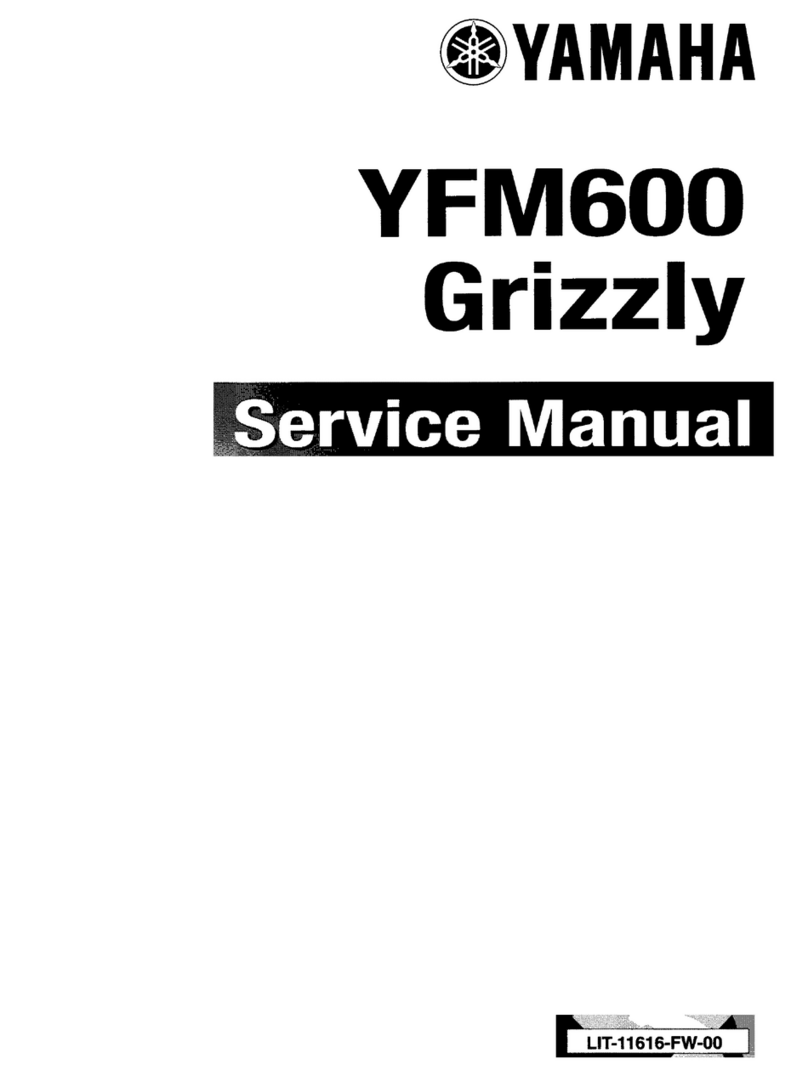
Yamaha
Yamaha EFM600 GRIZZLY Service manual

BOMBARDIER
BOMBARDIER ELAN 1988 Operator's manual
